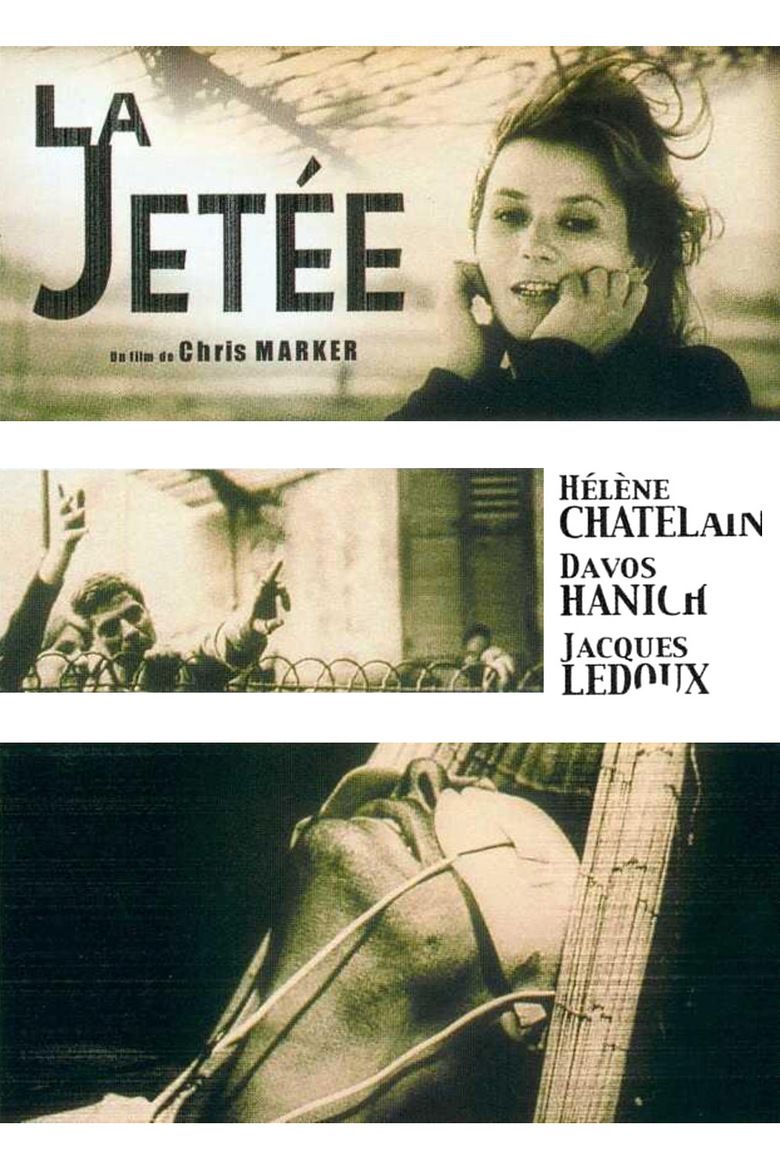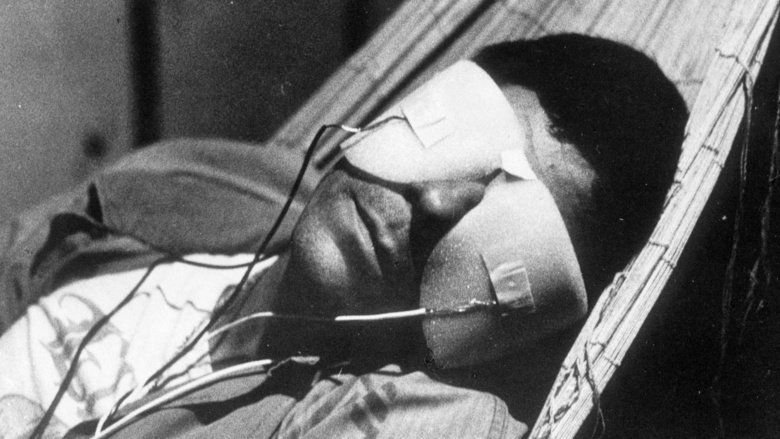La Jetée
8.6 /10 1 Votes
Director Chris Marker Languages French, German Country France | 8.4/10 IMDb 92% Rotten Tomatoes Genre Short, Drama, Romance Screenplay Chris Marker Duration Language FrenchGerman | |||||||||||||||||||||||||||||||||
 | ||||||||||||||||||||||||||||||||||
Writer Chris Marker (screenplay) Release date 16 February 1962 (1962-02-16) (France) Initial release February 16, 1962 (France) Cast Jean Négroni (Narrator (voice)), Hélène Chatelain (The woman), Davos Hanich (The experimenter), Jacques Ledoux (The experimenter), André Heinrich , Jacques Branchu Similar Charlotte and Her Boyfriend, Cyrano de Bergerac (1900 film), La Fonte des neiges | ||||||||||||||||||||||||||||||||||
La Jetée ([la ʒəte]) ("The Jetty," here referring to an outdoor viewing pier at an airport), is a 1962 French science fiction featurette by Chris Marker. Constructed almost entirely from still photos, it tells the story of a post-nuclear war experiment in time travel. It is 28 minutes long and shot in black and white. It won the Prix Jean Vigo for short film.
Contents

The 1995 science fiction film 12 Monkeys was inspired by and borrows several concepts directly from La Jetée.
Plot summary

A man (Davos Hanich) is a prisoner in the aftermath of World War III in post-apocalyptic Paris where survivors live underground in the Palais de Chaillot galleries. Scientists research time travel, hoping to send test subjects to different time periods "to call past and future to the rescue of the present". They have difficulty finding subjects who can mentally withstand the shock of time travel. The scientists eventually settle upon the prisoner; his key to the past is a vague but obsessive memory from his pre-war childhood of a woman (Hélène Chatelain) he had seen on the observation platform ("the jetty") at Orly Airport shortly before witnessing a startling incident there. He had not understood exactly what happened but knew he had seen a man die.
After several attempts, he reaches the pre-war period. He meets the woman from his memory, and they develop a romantic relationship. After his successful passages to the past, the experimenters attempt to send him into the far future. In a brief meeting with the technologically advanced people of the future, he is given a power unit sufficient to regenerate his own destroyed society.
Upon his return, with his mission accomplished, he discerns that he is to be executed by his jailers. He is contacted by the people of the future, who offer to help him escape to their time permanently; but he asks instead to be returned to the pre-war time of his childhood, hoping to find the woman again. He is returned to the past, placed on the jetty at the airport, and it occurs to him that the child version of himself is probably also there at the same time. But he is more concerned with locating the woman and he quickly spots her. However, as he rushes to her, he notices an agent of his jailers who has followed him and realizes the agent is about to kill him. In his final moments, he comes to understand that the incident he witnessed as a child, which has haunted him ever since, was his own death.
Cast
Production
La Jetée is constructed almost entirely from optically printed photographs playing out as a photomontage of varying rhythm. It contains only one brief shot (of the woman mentioned above sleeping and suddenly waking up) originating on a motion-picture camera, this due to the fact that Marker could only afford to hire one for an afternoon. The stills were taken with a Pentax Spotmatic and the motion-picture segment was shot with a 35mm Arriflex. The film has no dialogue aside from small sections of muttering in German and people talking in an airport terminal. The story is told by a voice-over narrator. The scene in which the hero and the woman look at a cut-away trunk of a tree is a reference to Alfred Hitchcock's 1958 film Vertigo which Marker also references in his 1983 film Sans soleil.
Interpretation
In Black and Blue, her study of postwar French fiction, Carol Mavor describes La Jetée as taking "place in a no-place (u-topia) in no-time (u-chronia)" which she connects to the time and place of the fairy tale. She goes on to say "even the sound of the title resonates with the fairy-tale surprise of finding oneself in another world: La Jetée evokes 'là j'étais' (there I was)". By "u-topia", Mavor does not refer to "utopia" as the word is commonly used; she also describes an ambiguity of dystopia/utopia in the film: "It is dystopia with the hope of utopia, or is it utopia cut by the threat of dystopia."
Tor Books blogger Jake Hinkson summed up his interpretation in the title of an essay about the film, "There's No Escape Out of Time". He elaborated:
What [the main character] finds ... is that the past is never as simple as we wish it to be. To return to it is to realize that we never understood it. He also finds–and here it is impossible to miss Marker's message for his viewers–a person cannot escape from their own time, anyway. Try as we might to lose ourselves, we will always be dragged back into the world, into the here and now. Ultimately, there is no escape from the present.
Hinkson also addresses the symbolic use of imagery: "The Man is blindfolded with some kind of padded device and he sees images. The Man is chosen for this assignment because ... he has maintained a sharp mind because of his attachment to certain images. Thus a film told through the use of still photos becomes about looking at images." He further observes that Marker himself did not refer to La Jetée as a film, but as photo novel.
Influence and legacy
In 1996, Zone Books released a book which reproduced the film's original images along with the script in both English and French.
Terry Gilliam's 12 Monkeys (1995) was inspired by and takes several concepts directly from La Jetée (acknowledging this debt in the opening credits). The 2003 short film, La puppé, is both an homage to and a parody of La Jetée. The video for Sigue Sigue Sputnik's 1989 single "Dancerama" is also an homage to La Jetée. The film is one of the influences in the video for David Bowie's "Jump They Say" (1993). Kode9 in collaboration with Ms. Haptic, Marcel Weber (aka MFO), and Lucy Benson created an homage to La Jetée in 2011, for the Unsound Festival. The plot centers around the woman instead of the man and is a "reimagining", in that it features a completely new, original script that further develops the narrative whilst remaining true to the original plot. The images and music of "Her Ghost" are almost exclusively sourced from the original film, however they are significantly reworked so as to create an original piece. A live performance of "Her Ghost" was part of the Chris Marker retrospective at Centre Pompidou in Paris 2013.
'In 2010, Time ranked La Jetée first in its list of "Top 10 time-travel movies". In 2012, in correspondence with the Sight & Sound Poll, the British Film Institute deemed La Jetée as the 50th greatest film of all time.
In 2017, Indie outsider singer-songwriter Cyclope Espion makes a reference to "La Jetée" with the cover artwork of his album Friday Night Epitaph on which a song titled Indélébile is inspired by the film.
Home media release
In Region 2, the film is available with English subtitles in the La Jetée/Sans soleil digipack released by Arte Video. In Region 1, the Criterion Collection has released a La Jetée/Sans soleil combination DVD / Blu-ray, which features the option of hearing the English or French narration.
